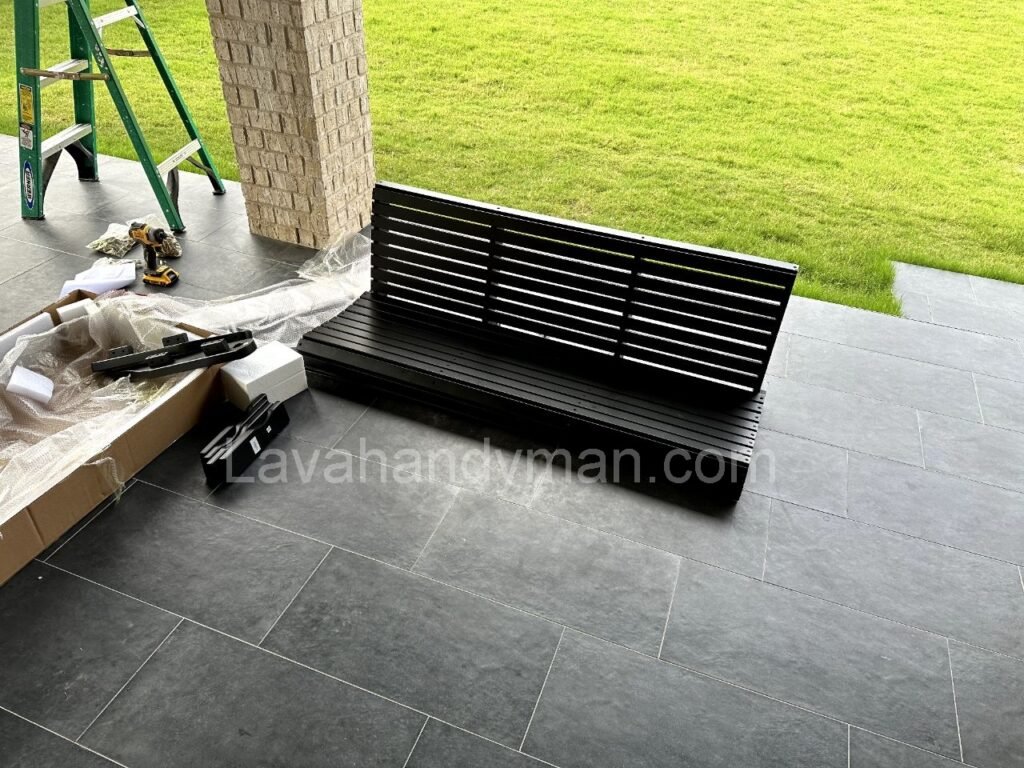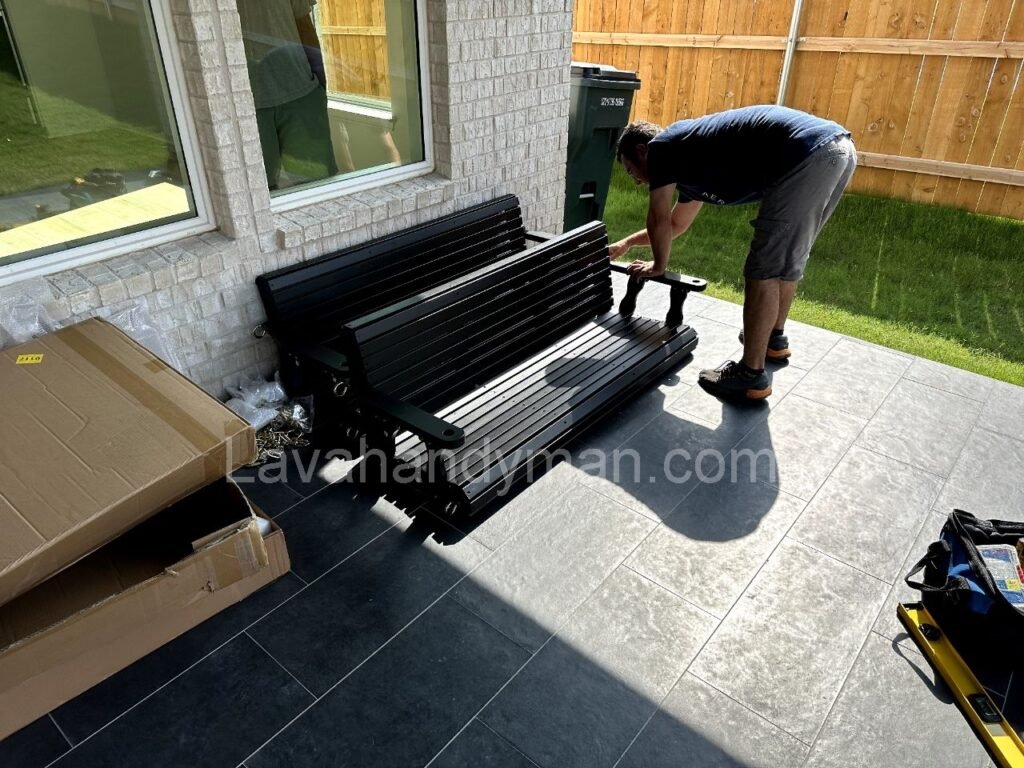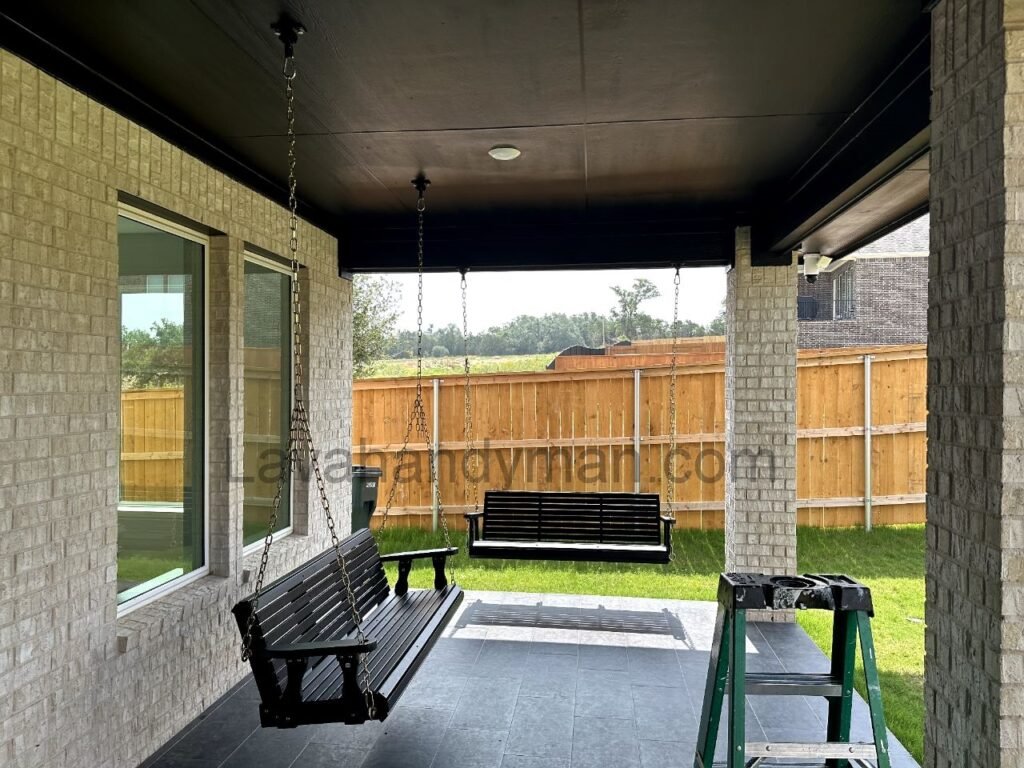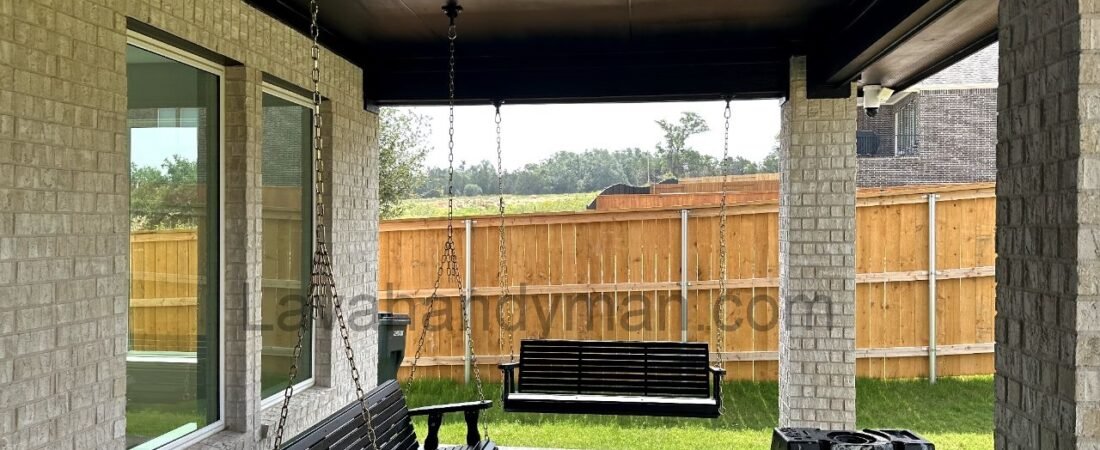Installing a Family Swing at Home: A Comprehensive and Practical Guide
Introduction
A swing is one of the most enjoyable and relaxing items you can add to your home. Whether placed on a balcony, in the living room, or the backyard, it can create a cheerful, cozy atmosphere for the whole family. In this guide, you’ll learn everything about choosing, installing, and maintaining a family swing—from safety tips and tools to step-by-step instructions and creative decoration ideas.
1. Types of Family Swings
Swings suitable for indoor or home environments generally fall into four main categories:

Installing a Family Swing at Home: A Comprehensive and Practical Guide
1.1. Ceiling (Hanging) Swing
- Attached to the ceiling using hooks and chains or ropes
- Ideal for spaces with strong ceilings or beams
- Weight capacity: typically 100 to 300 kg
1.2. Freestanding Swing
- Does not require a ceiling
- Can be used in yards, balconies, or indoors
- Has an independent metal or wooden frame
1.3. Multi-Person Family Swing
- Designed for 2–4 people to use simultaneously
- Best suited for spacious outdoor areas
- Usually includes a canopy or backrest
1.4. Fabric or Inflatable Swing
- Lightweight and portable
- Ideal for small or temporary spaces
Installing a Family Swing at Home: A Comprehensive and Practical Guide
2. Safety Tips Before Installation
Following basic safety principles is crucial to avoid accidents and ensure durability:
- Check ceiling or frame capacity: The structure must support the weight of the swing and all users combined.
- Use certified hardware: Hooks, chains, screws, and anchors must meet safety standards.
- Leave enough clearance: Ensure at least 70 cm of free space around the swing for safe movement.
- Ensure balance and level: Uneven installation can cause tilting or falling.
- Child safety: If children will use the swing, consider safety belts and soft edge covers.
3. Choosing the Right Location
Selecting the right spot is key to both safety and enjoyment. Consider the following:
- Strong ceiling: Look for wooden beams, steel bars, or reinforced concrete. Avoid false or gypsum ceilings.
- Balcony or terrace: A great option if there’s a solid ceiling above.
- Yard or garden: Use a freestanding swing if no roof is available.
- Indoors: Small hanging swings or fabric hammocks can work well in living rooms or children’s rooms.
Installing a Family Swing at Home: A Comprehensive and Practical Guide
4. Tools and Materials Needed
Before starting, gather the following items:
- Heavy-duty ceiling hook (up to 300 kg)
- Wall plugs and screws
- Strong chain or braided rope
- Electric drill and suitable drill bits
- Measuring tape and spirit level
- Screwdriver and wrench
- Swing stand (if not attaching to the ceiling)
Installing a Family Swing at Home: A Comprehensive and Practical Guide
5. Installation Steps
5.1. Step One: Choose the Location
- Mark the center point on the ceiling or wall
- Use a level to ensure alignment
- Check for adequate surrounding space
5.2. Step Two: Install the Hook
- Drill into the marked spot
- Insert the wall plug
- Screw in the ceiling hook securely
5.3. Step Three: Attach Chain or Rope
- Connect both ends to the hook and swing
- Adjust the swing’s height based on user needs
- Ensure the swing is balanced and centered
5.4. Step Four: Safety Test
- Gently move the swing by hand
- If it swings smoothly and silently, the installation is good
- Perform a weight test using an adult or heavy object
Installing a Family Swing at Home: A Comprehensive and Practical Guide
6. Maintenance and Safe Use
To ensure long-term performance and safety:
- Regular inspection: Check hooks, screws, and chains monthly
- Cleaning: Wipe fabric parts and treat metal parts with anti-rust solutions
- Cover: Use a waterproof cover when not in use, especially outdoors
- Adjust height: Review and change height settings as children grow
- Soft ground protection: Place a mat or soft rug under the swing to reduce injury risks
7. Decorative Ideas
A swing isn’t just practical—it can be a beautiful part of your home décor:
- Add colorful cushions or textured pillows
- Hang string lights or soft LEDs around the swing
- Use traditional or lace fabrics for added charm
- Place hanging flower pots or small plants nearby
Installing a Family Swing at Home: A Comprehensive and Practical Guide
🔧 Tools and Equipment Needed to Install a Family Swing – With Complete Explanations:
Installing a family swing requires the use of specific tools depending on the type of swing (ceiling-hanging or freestanding). Below, we’ve categorized the tools into main tools and optional accessories, explaining their use and important tips.
🔹 1. Ceiling Hook (Hook Bolt)
Use:
Ceiling hooks are used to hold the swing’s chain or rope securely to the ceiling. They must support a heavy load (at least 200 kg).
Important Tips:
- Choose galvanized steel or stainless steel hooks.
- Hooks with locking nuts provide extra security.
- The hook’s thread diameter should match your drill bit and wall plug.
Installing a Family Swing at Home: A Comprehensive and Practical Guide
🔹 2. Wall Plug and Screws
Use:
Wall plugs (anchors) are inserted into the ceiling or wall to firmly hold the screws and hooks in place.
Tips:
- For concrete ceilings, use heavy-duty plugs (e.g., metal or butterfly anchors).
- Make sure the plug diameter matches the drill bit and screws used.
🔹 3. Heavy-Duty Chain or Rope
Use:
The chain or rope connects the swing to the ceiling hook and must support dynamic weight and movement.
Types:
- Galvanized steel chain (durable and rust-resistant)
- Braided polyester rope (softer, safer for children)
- Decorative jute or hemp rope (for a rustic or boho look)
Tips:
- Only use ropes or chains labeled for “high load capacity.”
- Adjust the length to match your ceiling height.
Installing a Family Swing at Home: A Comprehensive and Practical Guide

🔹 4. Electric Drill
Use:
Used to drill holes in ceilings or walls for mounting hooks.
Tips:
- Use the correct bit type depending on ceiling material (wood, concrete, drywall).
- For concrete, a hammer drill is recommended.
- Wear safety goggles when drilling.
Installing a Family Swing at Home: A Comprehensive and Practical Guide
🔹 5. Appropriate Drill Bits
Use:
Choose a drill bit that matches the size of your plugs and screws.
Quick Guide:
- Use a 10 mm bit for a 10 mm wall plug.
- Use wood bits for timber ceilings, masonry bits for concrete.
🔹 6. Spirit Level
Use:
Ensures the swing is level and properly aligned for safe and even movement.
Tips:
- Use it to make sure both hook points are at equal height.
- Laser levels offer more precision if available.
🔹 7. Tape Measure / Laser Meter
Use:
For accurately measuring distances, swing height, and space requirements.
Recommendations:
- The swing seat should be 40–50 cm above the ground.
- The space between two ceiling hooks should match the width of the swing (typically 50–80 cm).
🔹 8. Wrench or Screwdriver
Use:
Tightening hooks, bolts, or swing connectors.
Tips:
- Allen wrenches may be needed for some swing models.
- An adjustable wrench (spanner) is great for tightening nuts.
Installing a Family Swing at Home: A Comprehensive and Practical Guide
🔹 9. Metal or Wooden Swing Frame (if no ceiling support)
Use:
If there’s no suitable ceiling, use a freestanding swing frame.
Features:
- Typically U- or A-shaped
- Must be rust-proof and wind-resistant (for outdoor use)
🔹 10. Optional Decorative and Safety Accessories
- Cushions or backrests: For added comfort
- String lights or LED bulbs: For ambiance
- Weatherproof cover: Protects outdoor swings
- Rug or mat underneath: Prevents injuries from falling
Installing a Family Swing at Home: A Comprehensive and Practical Guide
🧩 Tool Summary Table
| Tool | Primary Use | Key Consideration |
|---|---|---|
| Ceiling Hook | To attach the swing to the ceiling | Must support heavy weight; stainless preferred |
| Wall Plug & Screws | To secure the hook to ceiling/wall | Should match drill bit and ceiling material |
| Chain/Rope | To connect swing to ceiling hook | Must be tested for weight-bearing |
| Electric Drill | To drill holes in ceiling/wall | Choose correct bit and wear eye protection |
| Tape & Level | To measure and align swing installation | Prevents uneven or unsafe mounting |
| Wrench/Screwdriver | To tighten bolts and connections | High-quality tools prevent loosening over time |
| Swing Frame | Support for swing without ceiling | Must be stable, strong, and rust-resistant |
🌟 Importance and Features of a Family Swing at Home
✅ Why Is Installing a Family Swing at Home Important?
Installing a family swing at home is not just for fun—it offers numerous physical, emotional, and even decorative benefits. Below are the key reasons why a swing can be a valuable addition to your living space:
Installing a Family Swing at Home: A Comprehensive and Practical Guide
1. Creates a Joyful and Relaxing Atmosphere
Swinging evokes a childlike sense of freedom and relaxation. In homes with enough space, a swing becomes a peaceful spot for resting, reading, or meditation.
Benefits:
- Reduces stress and anxiety
- Improves mood and emotional balance
- Brings joy to both kids and adults
Installing a Family Swing at Home: A Comprehensive and Practical Guide
2. Strengthens Family Bonds
A family swing often becomes a natural gathering spot for chatting, laughing, or playing with children. This shared space encourages emotional connection among family members.
3. Suitable for All Ages
Unlike many play items, family swings are safe and enjoyable for children, teenagers, adults, and even the elderly. With the right design and safety measures, it can be a daily retreat for everyone.
4. Promotes Physical Health and Coordination
Swinging engages core muscles, enhances balance, and improves motor coordination. It’s particularly beneficial for growing children as part of their physical development.
5. Aesthetic Value in Home Decor
Whether minimalist and modern or traditional and cozy, swings can act as a unique design feature in your indoor or outdoor space.
Decorative Potential:
- Can be enhanced with lights and cushions
- Made with special fabrics or wooden elements
- Matches various decor styles: modern, rustic, boho, or classic
Installing a Family Swing at Home: A Comprehensive and Practical Guide
6. Multi-Functional Use
A swing can also serve as a comfortable seat, a reading nook, a breakfast bench, or even a nap spot. Some models even convert into a small bed.
⭐ Key Features of a Good Family Swing
When choosing a family swing for home installation, look for these essential features:
| Feature | Description |
|---|---|
| High Weight Capacity | At least 200–300 kg, allowing multiple users |
| Durable Materials | Rust-resistant metal or solid wood frame; washable or waterproof fabrics |
| Safety Elements | Child safety straps, soft edges, strong ceiling hooks |
| Easy Installation | Compatible with ceiling, wall, or stand-alone frames |
| Adjustability | Adjustable height and angle for different users |
| Attractive Design | Matches home décor style (traditional, modern, rustic, playful, etc.) |
Installing a Family Swing at Home: A Comprehensive and Practical Guide
Conclusion
Installing a family swing at home is one of the best ways to create joyful and cozy moments with your loved ones. By following the correct procedures and safety guidelines, you can enjoy years of comfort and entertainment. If you don’t have a suitable ceiling, opt for a freestanding model. When in doubt, consult a professional for secure installation. This small project can bring lasting happiness and connection to your home.
At LavaHandyman.com, we don’t just help you understand TV tech — we also offer expert TV installation services, making sure your home entertainment setup looks and performs at its best.
📞 Need Help?
Let us take care of the hard work while you sit back and relax.
📍 Serving: Austin, Round Rock, Cedar Park & more
📱 Call or Text: (737) 420-6992
🌐 Visit: https://lavahandyman.com


